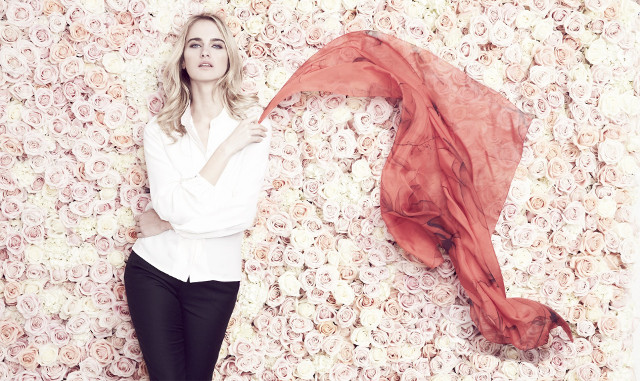The Duchess of Cambridge and the Politics of the Dress

(An ad for Beulah, a socially conscious British brand favored by the Duchess of Cambridge.)
The Duke and Duchess of Cambridge, William and Kate, are wrapping up their much-publicized tour to India and Bhutan. As always, Kate’s fashion choices are a favorite topic, and What Kate Wore is a thorough and excellent source for all of the sartorial details of the royal wardrobe, as well as for interesting tidbits from the trip itself. The Duchess’s pieces for this tour are obviously both carefully selected and culturally appropriate, and Kate seems to have moved outside her normal style and is trying brighter colors and bolder patterns, too.
The Duchess dresses like many women and favors a mix of high-end designer pieces combined with “high street” or fast fashion finds from brands like Zara. She is also frequently seen in dresses or suits by Beulah, a British brand working to improve the lives of trafficking victims, and in pieces by Roksanda, a luxury design house with pieces produced mostly in the United Kingdom, France, and Italy.
A few of Kate’s tour pieces have received a lot of attention, especially as Fashion Revolution Week quickly approaches. Earlier this week, Kate wore a dress from Anita Dongre that instantly became popular and crashed the designer’s site with a flood of orders. This article examines more about the popularity of the dress and gives readers a glimpse into the lives of the two seamstresses who worked on the piece, Babita Sabath and Chanda Padol.
For the third day of the tour, Kate wore a long-sleeve maxi dress from a little-known brand called Glamorous, which retails for around $40 at ASOS. I did a bit of research and could not find the origin of this piece, so I have to assume it’s a fast fashion design made in India, Bangladesh, or somewhere similar. The Duchess chose to wear it while she met with children living in a shelter, and I expressed my concerns about the dress in a comment on What Kate Wore. The site has a strict comment policy, and while my thoughts were polite and respectful, my comment was not published. On Tuesday, a fire broke out in a garment factory in Mumbai, and as many as 100 workers were trapped inside. It’s important to remember where our clothing comes from and who makes it, and just because a piece looks culturally appropriate for a specific situation does not, in fact, mean it is. I think this is a relevant conversation worth discussing and I was sad to see my comment censored on such an informative site.
Yesterday, the royal couple arrived in Bhutan, and Kate wore a traditional Bhutanese half-kira, a hand-woven skirt with intricately stitched designs, created by weaver Kelzang Wangmo. She is renowned for her work and has been honored by the Royal Textile Academy. What Kate Wore’s post on the kira is interesting and includes a short video of Wangmo as she reacts happily to news that The Duchess of Cambridge wore her design.
As Orsola de Castro explains in the article mentioned earlier, The Duchess of Cambridge is a “fashion revolutionary in the making.” While she hasn’t fully committed to wearing only ethically made clothing, she recycles and wears her clothing for many years, which is a great way to start on the path to sustainability. I’d love to see more ethical choices appear in Kate’s wardrobe, and I’m grateful that the popularity of her style allows for this discussion to take place.
Fashion Revolution Week begins Monday and you can read more about it here.
